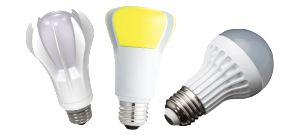 LEDs are energy-efficient. In fact, they consume even less power than CFLs. However, they are not exactly cheap. Most people are aware of the energy saving benefits of LEDs, but price is the biggest deterrent for them.
LEDs are energy-efficient. In fact, they consume even less power than CFLs. However, they are not exactly cheap. Most people are aware of the energy saving benefits of LEDs, but price is the biggest deterrent for them.
It is true that LEDs are expensive. There are, nonetheless, ways to make them more affordable. Here are some strategies for purchasing and using LED light bulbs.
Shopping for LEDs
Buy LED light bulbs when prices drop. Yes, it is a no-brainer, but investing in LEDs when their prices are pretty high doesn’t make any sense if cost saving is your goal. LED light bulbs are expected to be more affordable in the near future. Wait until prices drop before making a complete transition to them.
CFL or LED?
In a bid to make their homes more energy efficient, people are replacing incandescent light bulbs with better alternatives. Interestingly, CFLs aren’t the only option. LEDs are also becoming more popular in spite of their higher prices.
LEDs consume 75% less power. Better still, they last longer than incandescent light bulbs. LEDs are slightly more efficient than CFLs and when it comes to durability, they last much longer.
The only problem is that LEDs are expensive. An LED light bulb can cost anywhere between $20 and $40.
An average household has around 40 sockets. If you are going to buy LEDs for all of them, you will have to shell out $800 – $1600. That is not a small amount. A cost effective solution is to buy LEDs over time. Prices are also expected to drop because competition is heating up among LED manufacturers. Some experts expect a reduction of up to 50% in the price of LED light bulbs over the next 5 years.
LEDs last 3 times longer than CFLs. So if you don’t mind spending $10 on a CFL, you don’t have to think twice before spending up to $30 on a comparable LED light bulb. The average annual household energy bill adds up to $2,200. Lighting accounts for nearly 6% of this amount. If you do the math, you can see that you spend around $132 (6% of $2,200) per year on lighting.
Since LEDs are about 75% more efficient you will save up to $100 per year when you switch to them. LEDs not only save you money; they also recover their costs after 2 or 3 years.
If you can’t make a complete switch to LEDs overnight, you should at least replace frequently used incandescent light bulbs with LEDs. You can start with recessed lighting. These are usually installed in high usage areas like kitchens.
You should also use LEDs in open fixtures like table lamps. These fixtures allow air to circulate around the light bulb. LEDs don’t perform very well when they are placed in enclosed fixtures because of heat buildup.
Outdoor floodlights are usually high wattage and hence you will be able to make considerable energy savings if you replace them with LEDs. LED floodlights are not exactly cheap right now, but as technology improves, they will become more affordable. Wait until prices drop before investing in them.
Don’t replace bulbs in enclosed fixtures with LEDs. Because of heat build-up in these fixtures, they may burn out faster.
A word of caution
The quality of LED bulbs can vary widely. So don’t forget to choose LEDs with Energy Star labels.
